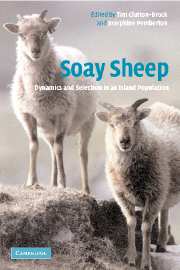Book contents
- Frontmatter
- Contents
- List of contributors
- Editors' and Authors' Acknowledgements
- 1 Individuals and populations
- 2 The sheep of St Kilda
- 3 Population dynamics in Soay sheep
- 4 Vegetation and sheep population dynamics
- 5 Parasites and their impact
- 6 Mating patterns and male breeding success
- 7 Selection on phenotype
- 8 Molecular genetic variation and selection on genotype
- 9 Adaptive reproductive strategies
- 10 The causes and consequences of instability
- Appendix 1 The flora of St Kilda
- Appendix 2 Inheritance of coat colour and horn type in Hirta Soay sheep
- Appendix 3 How average life tables can mislead
- References
- Index
- Plate section
7 - Selection on phenotype
Published online by Cambridge University Press: 07 December 2009
- Frontmatter
- Contents
- List of contributors
- Editors' and Authors' Acknowledgements
- 1 Individuals and populations
- 2 The sheep of St Kilda
- 3 Population dynamics in Soay sheep
- 4 Vegetation and sheep population dynamics
- 5 Parasites and their impact
- 6 Mating patterns and male breeding success
- 7 Selection on phenotype
- 8 Molecular genetic variation and selection on genotype
- 9 Adaptive reproductive strategies
- 10 The causes and consequences of instability
- Appendix 1 The flora of St Kilda
- Appendix 2 Inheritance of coat colour and horn type in Hirta Soay sheep
- Appendix 3 How average life tables can mislead
- References
- Index
- Plate section
Summary
Introduction
The long-term monitoring of selection on phenotypic traits in natural populations inhabiting fluctuating environments can provide valuable insights into interactions between ecological and evolutionary processes (Endler 1986). To date, some of the best-known examples of natural selection in the wild come from investigations in birds, particularly Darwin's finches which inhabit the extreme, and variable, environment of the Galápagos Islands (Grant 1986; Price and Boag 1987; Grant and Grant 2002).
The opportunity for selection is dependent on the extent to which individuals differ in fitness components such as survival and fecundity (Arnold and Wade 1984a, b). Although selection itself is acting on the phenotype of the individual and is measured at that level, for there to be an evolutionary response to selection there has to be genetic variation underlying the phenotype (Endler 1986). The measurement of a genetic response in free-living populations is far more challenging than measuring phenotypic selection alone.
The Soay sheep population is an ideal system in which to study selection because the periodic population crashes provide important opportunities for selection. By following the lives of marked individuals, we now understand some of the ecological factors that contribute to individual differences in both fecundity and survival (Clutton-Brock et al. 1991, 1992; see Chapter 3). In addition, we have shown that particular components of fitness are correlated with heritable morphometric (Illius et al. 1995; Coltman et al. 1999c; Milner et al. 1999a) and polymorphic traits, including coat colour and horn type (Moorcroft et al. 1996; Clutton-Brock et al. 1997b).
- Type
- Chapter
- Information
- Soay SheepDynamics and Selection in an Island Population, pp. 190 - 216Publisher: Cambridge University PressPrint publication year: 2003
- 2
- Cited by

